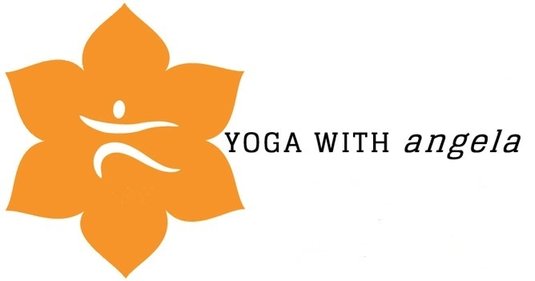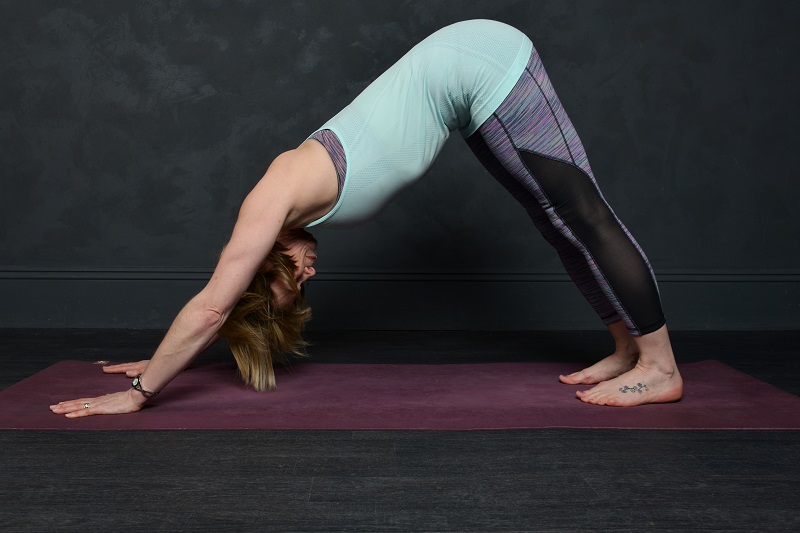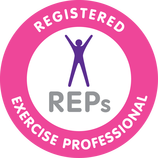People tend to know Adho Mukha Svanasana (”Downward Facing Dog”) more than any other yoga pose. It’s even becoming increasingly common as a warm-up or cool-down stretch in mainstream exercise classes. It has always been one of those poses that I have felt I could spend a whole class teaching, because although it looks simple and straightforward, there’s actually a great deal to think about and is definitely a pose where one size does not fit all. There’s no “right” and “wrong” way for how this pose should look; more than aesthetics, we should be concerned about what is safe, functional and accessible for our individual bodies.
Here’s how to do Downward Facing Dog
1 Place your hands on the floor
Connect your hands to the floor, gently spreading the fingers. In my experience, many people suffer with tight shoulders, including myself, so I like to turn the hands slightly out with the index fingers pointing forwards, which encourages a gentle external rotation of the shoulders and a connection of the palms to the earth. But it’s worth experimenting to see what works for you and what feels best, not just following instructions if it doesn't feel good for your body.
2 Your heels are supposed to touch the floor right?
Not necessarily! Some people's heels will touch the floor and some people's won't, and it’s not just to do with the length of the hamstrings and flexibility. It could be down to tight calves and the length of your Achilles tendon. A tendon is for stabilisation and it’s not a good thing to overstretch it. Heels not touching the floor may also have to do with bone structure — if there’s a lack of range of motion in the ankles, no matter how much you stretch the calves and hamstrings you will not get your heels to the ground.
It really doesn’t matter whether the heels touch the floor or not — usually it’s just an ego thing!
3 Forehead to the floor?
Through my years of practising Downward Facing Dog I have often heard that one of the ultimate goals is to get your forehead to touch the floor! Don’t worry — it really isn’t! It’s actually unachievable for most people. Pushing the chest back towards the thighs and taking the forehead towards the floor can cause the shoulders to collapse and create tension in the neck. If you have tight shoulders, trying to force the forehead to the floor does not make sense. It might be easier to think of bringing the pelvis into alignment with your head and keeping the spine in alignment.
4 What length should my Downward Dog be?
A very common way of establishing the length of your Downward Facing Dog is to start in plank pose, with your shoulders over your wrists and your heels above the balls of your feet. Without moving your hands or feet, press back into Downward Facing Dog. This is great for a vinyasa flow class and when you are moving through surya namaskara (otherwise known as Sun Salutation), but even this does not always work!
Sometimes when you are practising balance in Downward Facing Dog — in a three legged dog, for example, or just because your hands or feet keep slipping on the mat — you might need to narrow your stance. This is allowed!
5 Whether or not your heels are on the floor, should your legs be straight?
Most people I teach strive to get their legs straight in Downward Facing Dog, despite the pose feeling way more comfortable if they bend their knees! I watch clients work so hard to straighten their legs at the expense of the rest of the pose. By forcing the legs straight, it can cause the back to round and place too much stress on the hamstrings and heels.
I can easily straighten my legs and get my heels to the floor in Downward Facing Dog, simply because I have a long body and short legs. That means my feet don't have far to go to reach the floor! But a bent-knee Downward Facing Dog is as much as Downward Facing Dog as a straight-legged one!
6 Downward Facing Dog Alternatives
Depending on what injuries or issues you have with your body, you can get creative and customise your Downward Facing Dog to suit you. You could use blocks for your hands or you could do a forearm dog or even a puppy pose with the knees down.
No matter how how you practise your Downward Facing Dog, make it feel right for you.
1 Place your hands on the floor
Connect your hands to the floor, gently spreading the fingers. In my experience, many people suffer with tight shoulders, including myself, so I like to turn the hands slightly out with the index fingers pointing forwards, which encourages a gentle external rotation of the shoulders and a connection of the palms to the earth. But it’s worth experimenting to see what works for you and what feels best, not just following instructions if it doesn't feel good for your body.
2 Your heels are supposed to touch the floor right?
Not necessarily! Some people's heels will touch the floor and some people's won't, and it’s not just to do with the length of the hamstrings and flexibility. It could be down to tight calves and the length of your Achilles tendon. A tendon is for stabilisation and it’s not a good thing to overstretch it. Heels not touching the floor may also have to do with bone structure — if there’s a lack of range of motion in the ankles, no matter how much you stretch the calves and hamstrings you will not get your heels to the ground.
It really doesn’t matter whether the heels touch the floor or not — usually it’s just an ego thing!
3 Forehead to the floor?
Through my years of practising Downward Facing Dog I have often heard that one of the ultimate goals is to get your forehead to touch the floor! Don’t worry — it really isn’t! It’s actually unachievable for most people. Pushing the chest back towards the thighs and taking the forehead towards the floor can cause the shoulders to collapse and create tension in the neck. If you have tight shoulders, trying to force the forehead to the floor does not make sense. It might be easier to think of bringing the pelvis into alignment with your head and keeping the spine in alignment.
4 What length should my Downward Dog be?
A very common way of establishing the length of your Downward Facing Dog is to start in plank pose, with your shoulders over your wrists and your heels above the balls of your feet. Without moving your hands or feet, press back into Downward Facing Dog. This is great for a vinyasa flow class and when you are moving through surya namaskara (otherwise known as Sun Salutation), but even this does not always work!
Sometimes when you are practising balance in Downward Facing Dog — in a three legged dog, for example, or just because your hands or feet keep slipping on the mat — you might need to narrow your stance. This is allowed!
5 Whether or not your heels are on the floor, should your legs be straight?
Most people I teach strive to get their legs straight in Downward Facing Dog, despite the pose feeling way more comfortable if they bend their knees! I watch clients work so hard to straighten their legs at the expense of the rest of the pose. By forcing the legs straight, it can cause the back to round and place too much stress on the hamstrings and heels.
I can easily straighten my legs and get my heels to the floor in Downward Facing Dog, simply because I have a long body and short legs. That means my feet don't have far to go to reach the floor! But a bent-knee Downward Facing Dog is as much as Downward Facing Dog as a straight-legged one!
6 Downward Facing Dog Alternatives
Depending on what injuries or issues you have with your body, you can get creative and customise your Downward Facing Dog to suit you. You could use blocks for your hands or you could do a forearm dog or even a puppy pose with the knees down.
No matter how how you practise your Downward Facing Dog, make it feel right for you.


